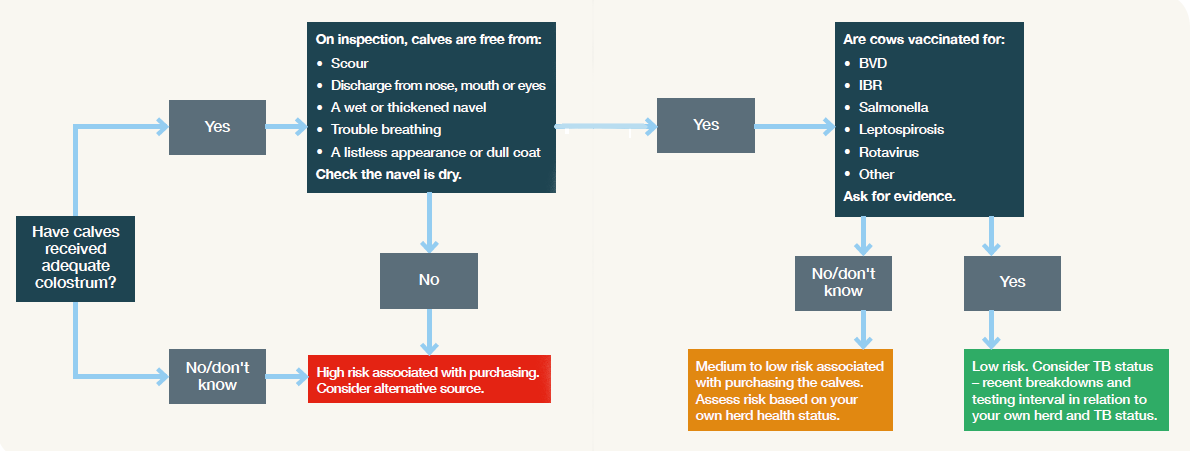- Home
- Knowledge library
- How to source calves for beef production
How to source calves for beef production
Success with rearing dairy beef depends on sourcing the right type of calves for the right price. Find out how to source dairy calves for beef production and the essential health checks you should be doing.
Back to: How to manage dairy beef production
How to assess the health of a calf
Well-grown, healthy animals have the greatest earning potential. They are likely to respond well to feeding and grow quickly.
Calves with poorer conformation have higher mortality rates during the rearing phase, and a generally variable performance during their life.
Learn more about where to handle live animals to assess conformation
Sourcing calves from a farm
Always aim to source calves directly from a farm with a known health status so you can be sure you are not introducing disease to the rest of your cattle.
When buying dairy calves directly from a farm, you will have the opportunity to ask more questions about the health and disease status of calves than purchasing at auction.
First, check the calves’ physical appearance.
Calves should:
- Be seven days old or more
- Well grown for their age*
- Have supple skin and a shiny coat
- Be alert and bright-eyed
- Have a dry and healed navel
- Show reasonable conformation
*Remember, liveweight alone is not a reliable indicator of future performance, but ‘weight-for-age’ is.
If you are unsure about the calves’ health after assessing their physical appearance, check their rectal temperature. A normal temperature is between 38.5 and 39.5 ̊C.
Weight-for-age vs liveweight
When assessing the earning potential of a dairy calf for beef production, you should use weight-for-age as an indicator rather than liveweight alone.
As a rule, the heavier the calf is at purchase relative to its age, the healthier it is likely to be and the better it will perform.
Trials have shown that calves with poor conformation at ten days old tend to be lighter, in terms of weight-for-age, compared with better-conformed calves.
When sourcing calves from a farm for beef production, you should also carry out the following checks:
Check 1: Colostrum management
When sourcing dairy calves from a farm, ask the farmer whether colostrum intake is a priority there?
Always buy calves which are known to have received adequate colostrum as newborns. There is a clear relationship between immune status when calves are very young and subsequent performance.
Check 2: Genetic merit of the sire
Ask about the sires used to produce beef calves, in particular the breed and bull identification. You can then do checks on their genetic merit for beef production.
Check 3: Type of dairy cows
It is useful to know the type of dairy cow in the farm’s herd so you can understand the influence on the calf’s frame size and conformation.
Check 4: Health status of the herd
Ask about the health status of the herd to understand the health risks associated with the calves.
Important diseases to ask about are:
- Bovine viral diarrhoea (BVD)
- Johne’s disease
- Infectious bovine rhinotracheitis (IBR)
- Bovine tuberculosis (TB)
See below for more details about sourcing cattle under a licence from TB-restricted premises.
Use the flow diagram below as a guide when assessing the health status of calves. It will help you to determine whether the calves are a good investment for dairy beef production.
How to assess the health status of dairy calves for beef production

Sourcing calves from an auction
When purchasing from a live auction, information on the calves’ health status will be limited.
If possible, ask vendors for more information on any routine vaccinations or treatments the stock may have had.
Visually assess the calves before making a purchase. The calves should:
- Be alert and bright-eyed
- Have a shiny coat
- Show reasonable conformation to enable finishing
- Be free from discharge from the nose, mouth or eyes
- Have no evidence of scours
Cattle from TB-restricted premises
When a herd is under a movement restriction due to bovine TB, cattle can only be moved under a licence issued by the Animal and Plant Health Agency (APHA).
It may be possible to move cattle off the premises if they are going to:
- Slaughter directly, from one TB-restricted premises to another, and to an approved finishing unit (AFU)
- A TB isolation unit
- Approved dedicated markets and calf collection centres (orange markets)
AFUs provide a route for rearing and finishing cattle from TB-restricted farms and can only be approved in the High Risk Area (HRA) and Edge Area of England, and the High TB Areas of Wales.
Rearing AFUs can purchase calves from multiple TB-restricted herds. At the appropriate stage in the production cycle, they can rear them and move them to another AFU set up to receive older stock.
All AFUs in England must have their own permanent county parish holding (CPH) number, be self-contained and isolated from other cattle with clear boundaries.
See the TBhub for farmers for more details about AFUs and TB-restricted farms. You can apply to become an AFU through the link below:
TBhub: The home of UK TB information
Apply to become an approved finishing unit (AFU)
Useful links
Access the ‘Dairy beef production systems' manual, for further practical advice
If you would like to order a hard copy of the Dairy beef production systems manual, please contact publications@ahdb.org.uk or call 0247 799 0069.

